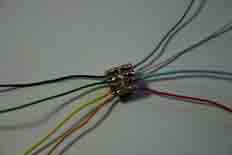





With a Zimo MX62 decoder installed it's done!
There's a picture of a slightly different socket fitted to Dave's NS 600 here.




| Back to Homepage |
| Back to Tips and Tricks Page |
| Link to Sitemap |
| Making DCC sockets | |||||||||
| When converting a loco to DCC it's great to be able to try different decoders to get the best performance. But it can be a fiddle to keep changing hard wired connections on those locos that don't come with standard NEM651 or NEM652 sockets. The solution? Make up your own sockets... |  |
||||||||
 |
|||||||||
| 1. We start with making the 6-pin NEM651 socket (8-pin NEM652 is at the bottom of this page). Mark off a 10mm strip in 60/1000" (1.5mm) plasticard. The marks for the six pins are put in now - could make a jig for this. | |||||||||
| 2. Deepen marks for pins into shallow grooves. These will take the wire sheathing later. The 0.6mm holes are then drilled in a line across the strip section. Snap strip from stock. | |||||||||
 |
|||||||||
 |
|||||||||
| 3. Cut off the section with the holes - around 5mm wide. The wires can then be prepared - they’re the sort of wire used for decoders and they’ll need tails in the region of 3mm long. By the way - the 'decoder' shown in the pics is actually the dongle from a Fleischmann BR22. | |||||||||
| 4. The wires are fed through the holes, turned over sharply and the sheathing is superglued in to the pre-cut channels. A little epoxy or more superglue can be used to form a bead over the sheathing. Leave to cure thoroughly. | |||||||||
 |
|||||||||
 |
|||||||||
| 5. The ends of the tails are quite scruffy at this stage and should be trimmed off against the hole. A quick continuity (or more accurately - lack of continuity) check is advisable at this stage to make sure none of the wires are touching. | |||||||||
| 6. The socket can then be installed into the loco - in this case my ÖBB 2067 with its scratchbuilt chassis. Using the correct colour coding for the wires helps enormously... With a Zimo MX62 decoder installed it's done! There's a picture of a slightly different socket fitted to Dave's NS 600 here. |
|||||||||
 |
|||||||||
 |
|||||||||
| 7. The parts for the homemade NEM652 socket are Maplin items FL17T (stripboard) and DC17T (modular connector strip). You'll also need wire to connect it into your loco. For clarity we've used the correct colours (flash eh?). Oh yeah; and a decoder with an 8-pin plug. That's a Zimo MX63 in the picture... | |||||||||
| 8. The stripboard is cut into squares 4-holes by 4-holes at a minimum. Larger pieces can be cut to allow for fixings etc. It needs the four tracks cutting down the middle with the edge of a triangular needle file before soldering in two sections of the socket strip. An old plug unit can be used to hold the socket strip sections in the proper alignment while soldering. | |||||||||
 |
|||||||||
 |
|||||||||
| 9. Front view of the completed, wired, socket... | |||||||||
| 10. ...and here's a view from underneath. This can now be stuck into the model where it's needed - foam centred 'sticky pads' are a good idea. | |||||||||
| Origin or real life as it exists / who does what: This page last updated 03/04/2005. Copyright © Steph Dale 2004,2005. All Rights Reserved. Steph Dale can be contacted through vesm_halleatyahoo.co.uk Don't forget to take out the 'at' and replace with an '@' in the email address. Sorry for the inconvenience but it should help cut out a load of spam... |